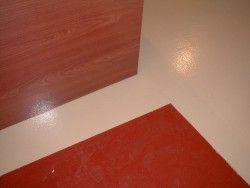Related Articles: Painting a Floor, Painted Floors, Floor Paint
DEAR TIM: We discovered a plumbing leak as we were getting ready to install a new laminate floor. The money for the flooring is now in the plumber's bank account. Since we have no money left for new flooring, is there a way to successfully paint the exposed plywood floor? How do you fill the depressions and cracks in the floor? Is it necessary to prime the wood before painting? Mark A., Hickory, NC
DEAR MARK: Are you sitting down? The answer is, "Yes!" It is not only possible to paint floors, the paint job just might end up better looking than the original laminate floor you intended to use. There is no real magic in painting a floor. You simply have to follow a few simple steps and use the right products to achieve durable and long-lasting results.
Just about any flooring surface that is in good shape can be painted. Concrete, wood, ceramic tile, sheet vinyl, vinyl tile, etc. can all be painted with ease. The only surface that may have problems would be an older basement concrete floor that is below grade or one that is in contact with a very wet soil. Water that seeps into concrete can sometimes cause a painted finish to peel. But many modern concrete floors installed since the 1970's have a vapor barrier under the slab. This moisture barrier often stops the water vapor allowing the paint to stick tenaciously to the concrete.

The paint itself will not yield a surface hard enough to resist years of foot traffic. You achieve durability and long-term good looks by coating the painted surface with three coats of clear urethane. Most people take for granted the hardness and durability of clear urethanes. For example, hardwood floors that are not coated with urethane can begin to look dingy and miserable in a short amount of time.
The thin coats of smooth urethane protect hardwood floors from dirt and other contaminants. It serves the same purpose over any painted surface. Visit any indoor basketball floor and you will quickly become a believer. Lines, logos and all sorts of things are painted on these floors. The paint looks good because of the invisible layers of urethane that are on top of the paint.
Painting floors begins just as any other painting project. The surface to be painted should be clean, dry, dust-free and as smooth as possible. Large depressions and cracks in the wood flooring need to be filled with a product that dries hard. Do not use caulk or lightweight spackling compounds as floor repair materials. There are any number of excellent plastic-type wood fillers that dry exceptionally hard. Certain floor leveling compounds that are mixed with water often dry very hard. Test these materials by walking on them after they dry. If they survive the walk test now, they will look good once painted.
Bare wood floors should be primed with special primer/sealer paints. These products work well to hide the wood grain that otherwise might show through the finish paint. Hardwood floors that have a varnish or urethane finish must be sanded before a primer is applied. Concrete floors may need a special masonry primer. Check the label of the finish paint you choose. Typically a paint manufacturer provides a list of compatible primers that work well with specific finish coat paint products. Oil paints work best for floor painting. The oil resins have a tendency to adhere better than water-based paints. They also tend to cure and harden faster.
You can dazzle your friends and neighbors if you incorporate some faux finishes into the painted floor. There are an infinite amount of possibilities. Stenciling, borders, pinstriping, etc. can all add accent touches to the floor. If you intend to have an area rug on top of the floor, you might consider creating a border that frames the rug equally on all sides. It is best to practice your faux finish technique on a piece of plywood. Once you feel you have the look, then begin to work on your floor.
Once the finish paint has dried two or three days, apply three coats of water-based urethane. The water based urethanes typically do not yellow over time. Be sure to look for the words "non-yellowing" on the urethane label. The key to keeping the floor looking good for a long period of time is to apply a single maintenance coat of urethane every two years.